New perk! Get after it with local recommendations just for you. Discover nearby events, routes out your door, and hidden gems when you sign up for the Local Running Drop.
The growing pains of Colorado’s legendary “Race Across the Sky”
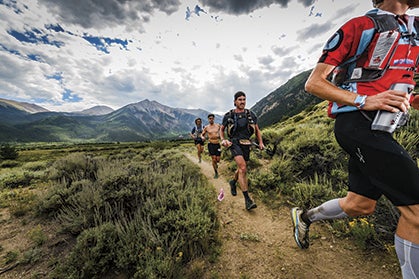
Photo by Scott Laudick
[Read Yitka Winn’s 2014 followup to this story: 5 Things That Were Different at Leadville This Year, and One That Stayed the Same]
The sun hadn’t yet risen, but it was getting close. Ribbons of deep purple and red streaked over the horizon, reflecting in the placid surface of the appropriately named Turquoise Lake. My footfalls were a metronome on the dirt—right, left, right, left—swirling up dust in the unsteady beam of my headlamp. As I ran, I watched the long, quiet trail of headlamps ahead and behind me, circling the lake like a necklace of pearls.
Then, abruptly, a voice spoke into my ear: “This is ridiculous!”
At first, I thought with joy, indeed, this is ridiculously amazing!
But then I felt a sharp jab to my side—an elbow, belonging to the runner behind me—as he pushed his way around me and barreled through the shuffling conga line of racers ahead.
“Can’t even run,” he muttered as he went by. “It better not be like this for 100 miles.” Several other runners followed suit, pushing past each other, trampling brush, rolling ankles along the root-and-rock-scattered edges of the trail. The friendly banter of the first few miles gave way to tension and thrown elbows.
Scott Jurek once wrote, “The ultra distance leaves you alone with your thoughts to an excruciating extent. Whatever song you have in your head had better be a good one.”
At 5:30 a.m. on a crisp Saturday morning in Colorado’s Sawatch Mountains, eight miles into the Leadville Trail 100, I worried that my song was starting off on the wrong note.
With its 31-year history hosting one of the country’s most prestigious 100-milers, the town of Leadville has become synonymous with ultrarunning. The highest incorporated American city, at 10,200 feet, it is home to 2,600 residents. Each August, its eponymous footrace travels from downtown Leadville to the 50-mile turnaround at the ghost town of Winfield, and back again.
Years earlier, after running my first trail 50K with a friend in Seattle, we’d proclaimed, “Next up—Leadville or bust!” and collapsed into giddy laughter at the improbability of it all. After all, we were nothing but starry-eyed novice trail runners, testing out the sound of wild ambitions.
The Leadville Trail 100 (LT100) was our point of reference—the ultimate challenge, the Boston Marathon of the trails. The town of Leadville was our Mecca. Someday, we imagined, we’d make the pilgrimage.
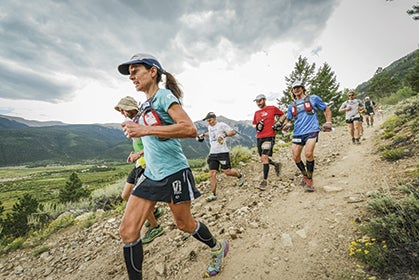
Racers cruise a long stretch of downhill early in the race. Photo by Scott Laudick.
It’s not hard to see how Leadville has entrenched itself in the minds, hearts and bucket lists of trail runners everywhere. All it takes is one encounter with Ken Chlouber, the former miner, politician and self-proclaimed cowboy who co-founded the LT100 with Colorado Ultra Club’s then-president Jim Butera; Chlouber’s passion for Leadville is as colossal as the mountains that surround it.
“Leadville is a historic mining community where success means never giving up,” he says. “Never quit. Dig deep. We encourage [runners of the LT100] to take that attitude home, make it part of their family, their job, their community.”
Leadville is also unique for its longevity, as one of the oldest ultramarathons in America. More than half of the 118 100-mile races in North America have cropped up in just the last five years. Unlike many other 100s, there are no barriers to entry into Leadville—no qualifying races, no lottery, no requirements other than willingness to shell out the entry fee.
And, from the beginning, Chlouber and longtime co-race-director Merilee Maupin have used the word “family” to describe what sets them apart from other ultras. At the finish line, every runner gets a hug from Maupin.
In its inaugural race in 1983, the race drew 45 runners. In 2013, it sold out its 1,200 spots months in advance.
“It used to be like a small family reunion where you could look forward to seeing the same family every year,” says Leadville resident Marge Hickman, who has entered every race since 1984 and has 14 finishes under her belt, including a win in 1985. “Now, everybody has discovered what we always knew and wants to be a part of this gigantic family.”

Winfield aid station at mile 50, with piles of drop bags lying in the foreground. Photo by Adam Danforth
Part of the appeal of Leadville is that it is, in a way, the “everyman’s ultra.” Chlouber’s rebellion against what he perceives as the elitism of other 100-mile races has granted first-timers the opportunity to tackle the tremendous challenge that Leadville presents, alongside legends like Jurek, Matt Carpenter and Ann Trason. With a mountainous course that fluctuates between a dizzying 9,200 and 12,600 feet and boasts six major climbs and a stiff 30-hour cutoff—signified by a shotgun at 10 a.m. on Sunday—it’s no walk in the park, either.
“What never gets old is the magic of being at the finish line for the final two hours,” says Garett Graubins, who’s run Leadville five times between 1998 and 2012. “You can take the emotions and inspiration of those two hours, bottle them up and tap into them for the next year.”
In 2010, something unexpected happened. Chlouber and Maupin sold the race, including their entire series of trail-running and mountain-biking races in Leadville, to Lifetime Fitness, a two-billion-dollar conglomerate of fitness mega-gyms across the country. Whispers echoed throughout the trail-running community about whether Leadville, with all its old-timey, cozy charm, would remain true to its roots.
Part of my journey was to find the answer to that question.
The sun had come up, and I was nearing the second major aid station, Outward Bound (previously known as Fish Hatchery) at mile 24. My support crew consisted of my dad, Steve Winn, who’d flown to Colorado for the weekend, and my boyfriend, coincidentally also named Steve, who planned to pace me for the last 40 miles. Though I’d run a handful of ultras over the years, my dad had never seen me race. I was thrilled to finally have the opportunity to share the trail-running scene with him.
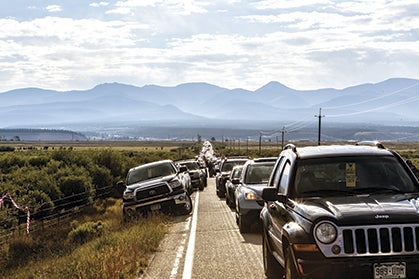
Racer crew vehicles try to reach Outward Bound aid station. Photo by Adam Danforth.
Outward Bound was a sprawling encampment of cars and cheering spectators in folding chairs. The energy in the air was palpable, and a welcome respite from a long stretch on pavement. I heard my name being yelled, but it took a moment to scan the crowd and lock eyes with my grinning crew. I jogged over to them.
“You look great!” my dad enthused, beaming as widely as I’d seen since my college graduation day. He motioned to an empty camp chair. “Sit, sit!”
“What do you need?” Steve asked, popping open a cooler of homemade fuel.
As I grabbed haphazardly at my snacks, I asked, “How’s it going here?”
“Oh, my God,” my dad said, “It’s a mess. I mean, this is amazing, seeing you do this. But, we just sat in traffic for an hour, trying to get here in time to meet you. There are too many cars. No one is directing anything.”
I gulped down a smoothie and eyed the carousel of runners streaming through the aid station. Runners barked their bib numbers at volunteers, whose task it was to retrieve drop bags from nearby heaps. Despite ample trashcans, runners scattered paper cups and wrappers on the ground around them like confetti.
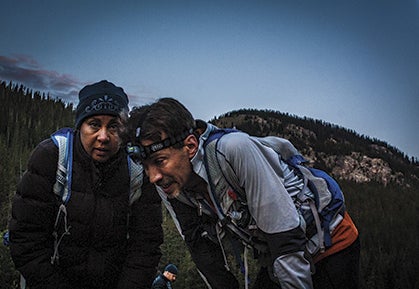
Just 13 miles to go. A runner (with crew member) catches his breath at the May Queen Campground aid station, inbound. Photo by Shay Skinner.
Since Lifetime Fitness took over, Chlouber and Maupin have remained heavily involved with the race. They insist that it has not lost the “family feel” they’ve worked to maintain since day one.
“If you hear any complaint that’s it not a Mom-and-Pop operation anymore, that’s just pure bullshit,” says Chlouber.
Some runners aren’t so sure. Many have voiced concerns that the LT100 has devolved over the years and lost some of its soul. Of the 2013 race, second-place finisher Nick Clark told me later, “It seemed like the pre-race and post-race [festivities] had lost a lot of the old Leadville that people who’ve been doing this for awhile have become accustomed to. It felt a little more sterile—get them in, get them out.”
By charging its runners $285 for the chance to toe the starting line, Lifetime brings in a third of a million dollars in entry fees—let alone additional sponsorships and race merchandise sold at their retail store in Leadville. But, is its profit-prioritizing so different from the Leadville of yore?
The race has always been, first and foremost, about money. When I asked Chlouber what inspired him to create the LT100, he said, “It wasn’t so much inspiration as necessity.” After the unexpected shutdown in 1982 of the local Climax Molybdenum Mine where Chlouber worked, the community lost 3,200 jobs and, overnight, was pegged with the highest unemployment rate in the nation.
The race was born, Chlouber told me, as a way to bring people and their wallets to town. In subsequent years, new races—mountain-bike events and shorter-distance runs—were added. A recent economic impact study conducted by Colorado Mountain College estimated that the Leadville Race Series brings $15 million annually to the local community. And, in 2002, Chlouber and Merilee established a foundation that donates $1,000 of race series profit to every single graduating senior at Leadville High School to put toward higher education.
It’s just so worked out that, for three decades, racers have seemed to get as much out of Leadville as vice versa.
2013, however, may be the year the tables turned. In the days following the race, the blogosphere flooded with feedback from disgruntled runners. Those who shell out substantial entry fees for big-name races—particularly those put on by for-profit corporations with full-time employees and million-dollar budgets—have high expectations. Many complained about course overcrowding, runner collisions, traffic jams for crews, lack of medical supplies, depleted and even deserted aid stations.
“We’ve been coming here around seven years now and have always loved it and made it a big part of our lives,” wrote one runner on the Leadville Race Series Facebook page. “For the past three years since Lifetime took over, it has gotten greedier and worse. I can write a book on this weekend and how this was the worst race we have ever been a part of.”
On the other side of the coin are runners like Travis Macy, who this year snagged the “Leadman” title for completing five Leadville Race Series races—including both the 100-mile mountain-bike race and the LT100—in the fastest combined time. Leadville is in his blood; he watched his dad, Mark Macy, run it for the first time in 1988, and many times after that. Several other members of his family have also run it.
Though Macy acknowledges that the race’s atmosphere has changed over the years, he sees no problem with the unprecedented numbers of runners. “Despite whatever challenges or overcrowding,” he says, “more people are out there doing something that pushes their limits and changes them as human beings. I think that’s awesome.”
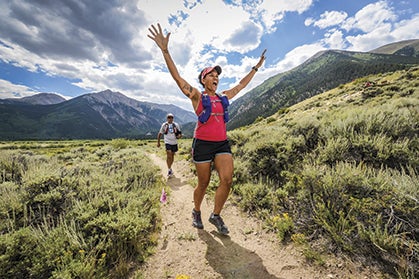
Two race spectators having a good time on the course near Twin Lakes. Photo by Scott Laudick.
The climb from Twin Lakes, at mile 40, up and over 12,600-foot Hope Pass was exhilarating. Rocky, steep terrain buried in thick forest forced me to pay close attention to my footfalls. It was the kind of technical terrain I loved most. My lungs seared as I climbed into thinner and thinner air, and the sight of Twin Lakes, glittering in the beaming afternoon sun, slowly fell away below me. The woods were—as Robert Frost once wrote—lovely, dark and deep.
Early into my climb, the first frontrunners and their pacers came tearing down the trail in the opposite direction. I cheered for each of them—Ian Sharman, Michael Aish, Nick Clark, Scott Jurek—as they crashed gracefully past me, each grinning with the bliss of surrendering to gravity.
Just below the windy saddle of Hope Pass lies Hopeless Aid Station. It’s an inaccurate name for what is, in fact, a gleaming icon of joy amid the race’s most grueling climb. Kids volunteering at the aid station rushed out to us as we approached, cheering and whooping, asking what we needed and sprinting back toward the aid station with the dedication of a NASCAR pit crew. Llamas—who shuttle in the aid station supplies at Hopeless—lounged nearby in the sunny grass. It was a good excuse to look back down the valley, the town of Leadville merely a speck in the distance, and see just how far I’d come.
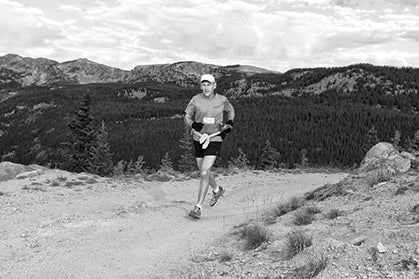
Pictured in the 2013 race, Bill Finkbeiner holds the male (30) record for most LT100 finishes. Finkbeiner ran it for the first time in 1984. Photo by Zazoosh Media
Shortly after leaving Hopeless, I exchanged an elated hug with my predecessor at Trail Runner, Ashley Arnold, who was on her way to winning the women’s race. As we headed off to our respective descents on either side of the pass, I eyed the two-way runner traffic on the other side.
I tend to run descents fast, and often make friends on downhill stretches of trail runs. At many other races, fellow runners had cheered me on with, “Go get ’em, sister!” or something similar. Today, the first runner I blazed by called out after me, with an air of bitterness, “Nice work trashing your quads!”
A minute later, as I passed another runner and his pacer, I heard one mutter to the other, “There’s no way she’ll make it to the finish line, running like that.”
No one was in a good mood, it seemed. And, by the time I got to the bottom of Hope Pass again, neither was I. The final stretch before Winfield consisted of a quarter mile along a dusty road. Hundreds of cars lined both sides of the road, bumper-to-bumper and inching along. Horns honked; people yelled. There was nowhere for runners to go except to weave between the cars,faltering on shaky legs and coughing in the thick cloud of dust and exhaust.
When I finally made it to Winfield, my crew was nowhere to be found. I spent a few unceremonious minutes gulping down water at the aid station, then turned around and began the long journey back to Leadville. A few hundred feet up the road, I saw Steve coming toward me, running through the maze of cars.
“I’m so sorry!” he called out. “We couldn’t make it to the aid station to meet you. Your dad’s still farther up the road, stuck in traffic. It’s backed up for miles.”
According to Tami Conner and Bill Mulholland of the Forest Service Leadville Ranger District, Lifetime Fitness’ permit—which expires in September 2015—allows for “about 850 participants” in the LT100.
However, in 2013, 943 runners showed up to the starting line, an 18-percent increase over 2012’s 795 runners. Lifetime Fitness’s decision to admit an unprecedented 1,200 runners (versus 1,100 the previous year) was based on a 30-year-history of statistically consistent no-show rates.
“We’re not sure what happened,” says race director and longtime Leadvillite Josh Colley. “More people showed up than normal.”
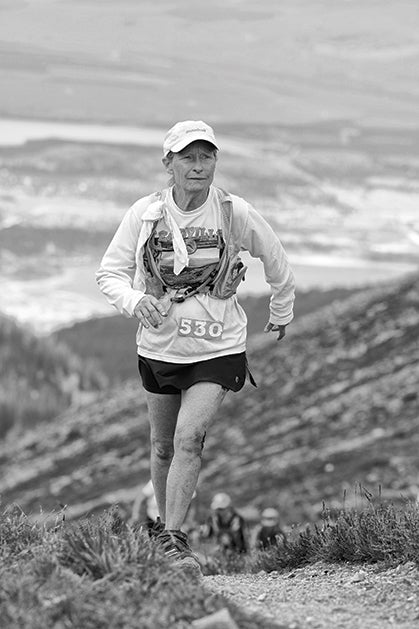
Marge Hickman holds the record for the most female (14) finishes at LT100. She ran her first in 1984. Photo by Zazoosh Media
In comparison, the next three biggest trail 100s in the country—Western States, Rocky Raccoon and Vermont—all cap their races at 300 to 400 runners. Moreover, 75 percent of all 100s in the U.S. start fewer than 100 runners.
When I asked Conner and Mulholland what went into determining 850 to be the number of runners whose impact the trails could handle at once, they told me, “That was done many years ago. We’re not sure what went into it. It could have been what [the race director] requested, the number he wanted to have, and felt was good in the race.”
Colley admits that 943 seemed like too many runners on the course. Next year, he says, he’ll work to keep numbers closer to 750.
But, already, damage has been done. In October, the Hardrock 100 Endurance Run, another of Colorado’s most prestigious, historic ultras, announced on its website that Leadville (among several other notable 100s, including Western States, Massanutten and Tahoe Rim Trail) will no longer count as a qualifying race.
“The Leadville 100 includes many of the features that are important for a HR [Hardrock] qualifier: high altitude, long climbs, potential for mountain weather, and more,” says the HR website. “However, the 2013 Leadville 100 ignored other traits of importance to the HR: environmental responsibility, support of the hosting community, and having a positive impact on the health of our sport.”
Indeed, the relationship between the town, the Race Series and the greater trail-running community remains tenuous. While many locals embrace the Race Series as the town’s lifeblood, not all share the warm fuzzy feelings.
On Sunday morning following the conclusion of the 2013 LT100, the popular post-race brunch spot in town, the Golden Burro, shuttered its doors. It left a note for runners: “Our city, this little café and our entire staff are finally so stressed out over trying to handle these huge crowds that … we finally decided we simply can’t do it any more. These multiple races are NOT profitable in relation to the costs involved in high payrolls, overtime and double shifts, higher food costs, etc … it’s clear the shear [sic] volume of races eventually becomes a no-win situation for everyone.”
As Bill Finkbeiner, who’d just run his 30th consecutive LT100, stood in front of the Golden Burro that morning, disappointed to miss out on his post-race breakfast tradition, the owner of nearby pizzeria High Mountain Pies stopped to say hello. When she saw the sign on the Burro’s doors, she told Finkbeiner and his friends, “We don’t open until 11, but why don’t you come on over, and I’ll make you a breakfast pizza with scrambled eggs and bacon.”
Finkbeiner, who lives in Auburn, California, says small-town moments like these are part of what makes Leadville so special. “With Wasatch or Western States,” he says, “you can go through Salt Lake City or even Auburn on race weekend and not even sense that something’s going on. In Leadville, the whole town is behind it, it seems.”
On the other hand, local residents are often unable to find parking in town on race weekends, including at the post office where many pick up their daily mail. Some are unable to even reach their own homes. According to Loretta McEllhiney, a longtime local who ran the LT100 twice in the late 1990s, Leadvillites have a saying: “When Labor Day comes, we’ll get our town back.”
By the time Sunday morning arrived, I’d been falling asleep while running (well, walking) on the trail for hours. After a rejuvenating nap at the May Queen aid station, I fell into a leapfrogging pattern with another runner over the last 13 miles.
As he ran, his pacer relayed details to him with a steady tone: “Rock to your right. Step up. A little mud. Rock to your left.”
Then I saw the sign on his back: “Blind Runner.”
There were things his pacer did not relay to him. Hundreds of gel and bar wrappers, half-eaten foil-wrapped sandwiches and plastic cups were strewn along the trail for miles. In places, piles of human waste lay several feet off the trail.
But, as we turned onto the final stretch back into Leadville, I thought also of the beautiful things he couldn’t see—the blue skies, the smiling crowds lining the street, the handmade signs congratulating us all for making it this far.
I crossed the finish in 29:27, feeling a mixed bag of emotions. Exhausted and proud, sure—but also, in some ways, let down. I’d made it to my Mecca, but I’d seen things I’d never expected to see—trashed trails, and everything from tension to frustration to outright animosity between runners. I wondered whether the overcrowding, and all its repercussions, was an outlier that could be addressed in future years, or whether it was simply a harbinger of what’s to come in our rapidly growing sport.
Should runners have done a better job respecting the trails, and each other? Should the Forest Service have been more discerning with its race permits? Should Lifetime Fitness have better planned race logistics, and avoided hedging their profits on the assumption that a third of registered runners wouldn’t show up?
The answer to all these questions is likely yes—but, assigning blame is less compelling than considering opportunities for positive change. As trail runners, we can choose every day to show more respect for the trails we tread, as well as for our fellow runners. In two years, the Forest Service will have the chance to renegotiate Leadville’s race permits.
As for the race organizers, Colley promises that Lifetime Fitness is hard at work seeking ways to improve the race for next year. “Seventy percent of what we do is ask, ‘How can we make this better?’” he says.
Next year, they plan to reduce the total number of runners by about 20 percent, offer more shuttles for crews, beef up aid-station supplies, hire professional crowd-control and parking crews, increase trash receptacles and consider new parking situations at Winfield.
“I want our aid to be the best in the industry,” says Colley.
When the Climax mine shut down 32 years ago, the LT100 played a pivotal role in saving the town of Leadville. Now that Leadville—the race, that is—is facing accusations that it has lost its soul, one question remains: Can Leadville be saved … again?
[Read Yitka Winn’s 2014 followup to this story: 5 Things That Were Different at Leadville This Year, and One That Stayed the Same]
Yitka Winn is Trail Runner’s Associate Editor. This article originally appeared in our January 2014 issue.
